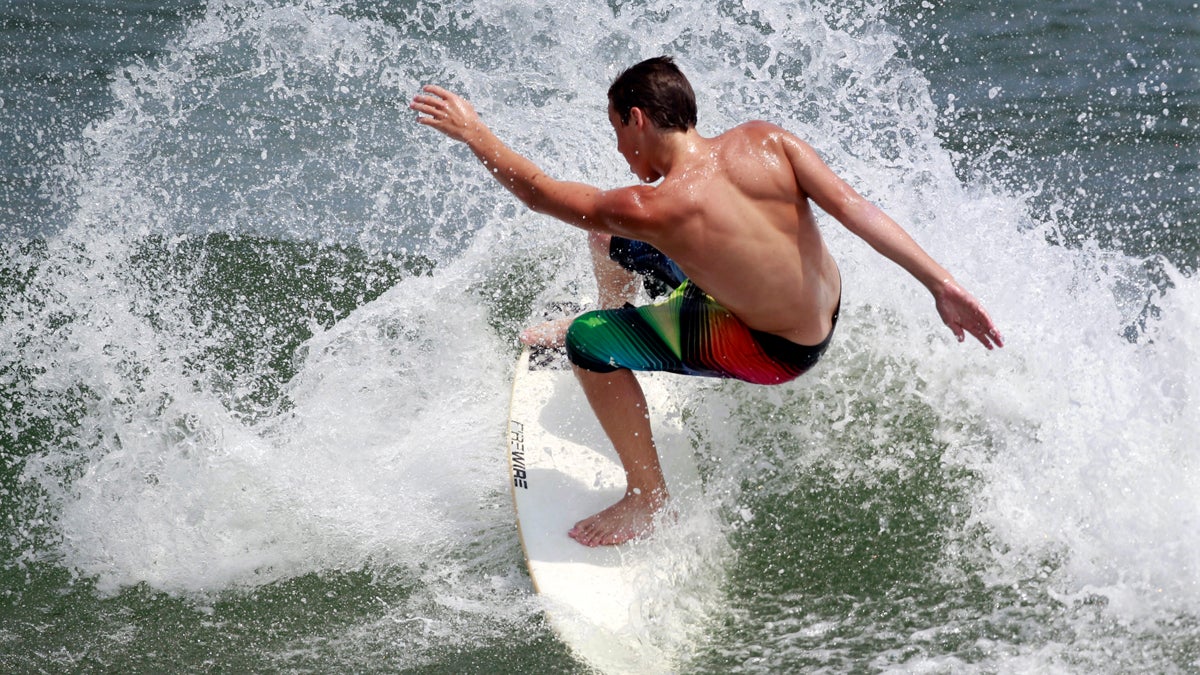The ocean seems warm at the Shore, but will temps hold?

A surfers is shown doing a spin-trick in Manasquan, N.J. (AP Photo/Mel Evans, file)
On a blistering summer day, nothing feels quite so good as taking a dip at in the ocean. But where along the Jersey shore can you find the not-too-cool, not-too-hot “sweet spot” for water temperatures, the one that provides just enough relief from the heat and makes you go “ahhhh”?
The answer is a bit unscientific, despite the ample science behind it. It’s hard to point to a perfectly temperate beach in New Jersey because there are many factors aside from consecutive hot days that play into shore water temperatures, which create a lot of unpredictable variation along the coast. But certain water temperatures are almost guaranteed to bring people to the beach.
“Most people like it to be at least in the mid to upper 70s,” said Josh Kohut, assistant professor of Physical Oceanography at Rutgers University and founding member of the university’s Coastal Ocean Observation Lab (COOL). “Certainly when we had upwelling last year and it got into the 50s that was a bit too cold for most people.”
If you’re a frequent beach-goer you’ll know exactly what Kohut is referring to – those unwelcome blasts of chilly water that occasionally interrupt an otherwise pleasantly warm swimming session. Here’s his Oceanography 101 explanation: A cold pool of water tends to sit just off most shores, far below the surface. The cold pool rests there unless disturbed by steady winds from the South or Southwest, in which case warm water is pushed away from the beach and the cool surge will be pulled toward the shore, hence an uncharacteristically cold surge. And this summer, we could be expecting colder surges than ever before.
[Learn more about the science of upwelling at The Pulse.]
“I would say that it’s likely that the cold pool is certainly cooler because of that winter – it was such a cold winter,” said Kohut. “But we haven’t seen any evidence of upwelling just yet. What we typically need is three to four to five days where we get those nice South-Southwesterly winds.”
So far it seems that the brutally cold winter hasn’t led to discernably colder surface water temperatures. Tim O’Brien, an emergency medical technician with the Wildwood Crest Beach Patrol who’s coming up on his 36th summer on the Jersey shore, says this year’s temperatures have been just about average.
“I live here year round and [the winter] was brutal just like it was in the city,” said O’Brien. “If anything the winter was so bad that people were even willing to brave the cold water!”
Travel a little further up the shore and Atlantic City Beach Patrol’s chief Rod Aluise will tell you the water has actually been warmer than usual.
“We’re seeing a lot more activity, much higher numbers than in the past,” said Aluise excitedly. “The water is extremely warm this year. Right now we’re in the low 70s!”
Aluise attributes this season’s above-average temperatures to steady easterly winds. As for the “sweet spot”, he said, “Everyone responds to 75, I’ll tell you that right now!”
Word on the beach is the once-predictable wind patterns have taken an inconsistent turn in the past few years.
“We used to have a dominant southeast wind, but now it’s more of a westerly and southwesterly wind that we see,” said Tim Husar, a year-round surfer at Seaside Park and Island Beach State Park who fishes often in Ocean County. “You used to be able to set your watch by it, but it’s been very erratic for the past three to four years.”
For surfers, Husar explained, the sweet spot is a little cooler than the average beach-goer might like. “Definitely the mid 60s is the sweet spot. Anything higher than that, like when you get water temperatures in the 70s, means that you don’t get much of a swell.”
Chris “Fletch” Anderson, another year-round surfer in South Seaside Park, which is commonly referred to as “Southtown,” says the water in Seaside Park took longer than usual to warm up this season.
“Not by very much – we may be talking anywhere from a few degrees to a five degree difference,” said Anderson. “But you would be surprised by how much five degrees makes a big difference in temperature.”
Anderson also attested to the dramatic day-by-day changes in water temperature that a beach can experience.
“Today is a great example of how the water changed in a matter of two days,” Anderson told NewsWorks on Wednesday. “Two days ago we had temperatures of about 72 and in a matter of two days, with a really strong south wind, it dropped 8 degrees!”
Anderson keeps track of daily changes in water temperature and wind direction using several apps, including Surfline, Swell Info, and MagicSeaweed.
It’s easy to reach consensus on water temperatures that are toe-curlingly cold (pre-May at the shore is generally reserved for the ultra brave), but is there such a thing as ocean water that’s too hot?
“For surfers, absolutely yes!” offered Anderson. “If it’s a really hot day, and I mean hot like high 90s with a lot of humidity, and you’re in water temperatures of 80 or above, you’re actually like, man, it is like, not as comfortable as I thought it would be! Absolutely!”
Next time you’re heading to the shore, check the wind direction and water temperature at your nearby beach at Surf-forecast.
WHYY is your source for fact-based, in-depth journalism and information. As a nonprofit organization, we rely on financial support from readers like you. Please give today.




